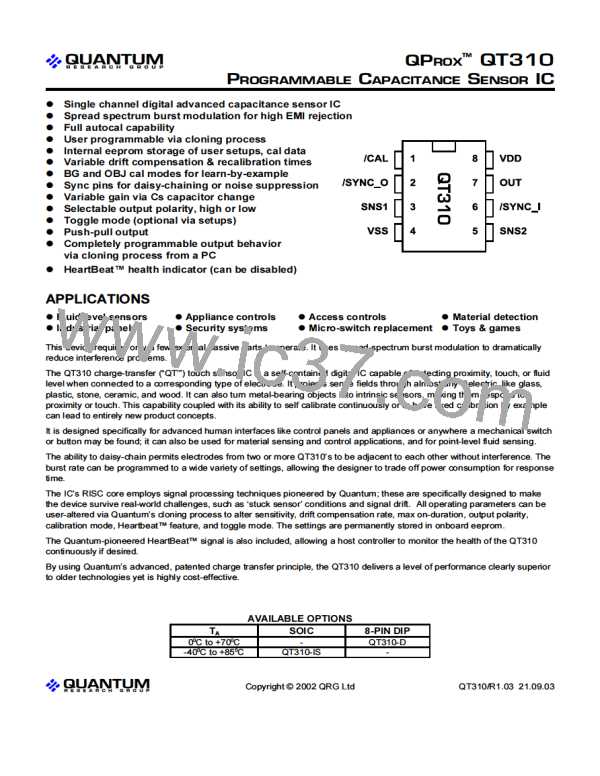Likewise, RF emissions are sharply curtailed by the use of
RE1, which bandwidth limits RF emissions based on the value
of RE1 and Cx, the electrode capacitance.
4 Parameter Cloning
The cloning process allows user-defined settings to be loaded
into internal eeprom, or read back out, for development and
production purposes.
3.5.1 LINE
CONDUCTED EMI
Line conducted EMI can be reduced by making sure the
power supply is properly bypassed to chassis ground. The
OUT line can also be paths for conducted EMI, and these can
be bypassed to circuit ground with an RC filter network. The
additional resistors RE2 through RE5 can also help with
conducted EMI.
The QTM300CA cloning board in conjunction with QT3View
software simplifies the cloning process greatly. The E3B eval
board has been designed with a connector to facilitate direct
connection with the QTM300CA. The QTM300CA in turn
connects to any PC with a serial port which can run QT3View
software (included with the QTM300CA and available free on
Quantum’s web site).
3.5.2 SPREAD-SPECTRUM
M
ODULATION
The connections required for cloning are shown in Figure 4-1.
Further information on the cloning process can be found in
the QTM300CA instruction guide. Section 3.3.2 above
discusses wiring issues associated with cloning.
The QT310 uses spread-spectrum burst modulation to
dramatically reduce susceptibility to external noise sources.
Spread-spectrum is implemented using frequency hopping
between four ‘channels’ centered around 240kHz. The
frequency of operation is altered with each successive burst;
the total frequency spread is approximately 7ꢀ.
The parameters which can be altered are shown in Table 4-1,
page 14.
It is possible for a host controller to read and change the
internal settings via the interface connections shown, but
doing so will disturb the sensing process even when data
transfers are not occurring. The additional capacitive loading
of the interface pins will contribute to Cx; also, noise on the
interface lines can cause erratic operation.
Spread-spectrum operates full-time and cannot be disabled.
If the DIAT (Detect Integrator terminal count) is set to DIAT=2,
then two different frequencies will be used to determine a
detection result. There is no way to control which two
frequencies are used, but they are guaranteed to be different.
If the DIAT (Detect Integrator) is set to 4 or higher, the
detection process will take advantage of all four possible
frequencies before confirming a result. All it takes is one
‘clear’ frequency for a false detection to be suppressed, since
a non-detection on one sample is enough to clear the DI
counter and abort a pending detection.
The internal eeprom has a life expectancy of 100,000
erase/write cycles.
A serial interface specification for the device can be obtained
by contacting Quantum.
LQ
13
QT310/R1.03 21.09.03

 QUANTUM [ QUANTUM RESEARCH GROUP ]
QUANTUM [ QUANTUM RESEARCH GROUP ]